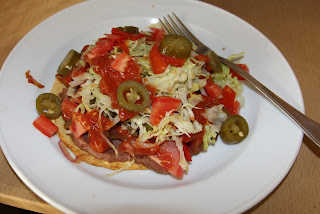We live in a great location within Madrid. Within easy walking
distance are major transportation stations that can get us to anywhere
in the city and almost anywhere in the world. Here are the major stores,
shops, and bus and metro stops in our area.
 |
| Satellite view of our neighborhood. Notice scale in upper-left corner, where 0.1 mi = 176 yards. |
Site 1 is the Madrid Spain temple
. Site 2 is our apartment building:
Site 3
is Condis, a nice grocery store where we can buy some fruits and
vegetables, nuts, raisins, tissue paper, canned and bottle goods, bread,
breakfast cereal, meat, yogurt, milk, drinks, etc. It's fairly complete
and only a few steps from our apartment.
 |
| Condis grocery store, below a large apartment building. |
|
Site 4 is Casa Elias, where we buy
most of our fruits and vegetables because they are the best in the area.
It also includes other groceries:
 |
| Casa Elias grocery store, with great produce. |
Between Sites 3 and 4 is an ATM where we
get all our cash ($350-$500 per day per credit card is the maximum
withdrawal from our U.S. bank and credit union):
 |
| Caja Madrid ATM |
Site 5 is a bus
stop, located right next to the temple. Here we catch Bus 32 that goes
to the huge Walmart-like department store Alcampo (about 30 min) and to
Madrid city center (about 50 min):
Site 6 is an area with many shops that we enjoy. Here is Beverly's hair salon:
 |
| Maja's Peluquería |
Here (still Site 6) is Scott's barbershop, next door to Maja's:
 |
| Peluquería de caballero |
Across the walkway (Site 6) from where we get our
hair cut are three little stores that we use a lot. The computer store,
where we bought our printer and WiFi router, and where we still buy our
printer ink:
 |
| App Informática computer store |
The hardware and electrical store (Site 6) where we bought tools, twine, plug adaptors, plug boxes, and other odds and ends:
 |
| Ferretería Electricidad Pavones |
And a Chinese odds-and-ends store (Site 6), similar to a Dollar store in the U.S.:
 |
| Super Euro (Chinese Store) |
Site 7 is a pharmacy, located near the hair shops:
 |
| Pharmacy on Hacienda de Pavones street |
Site 8 is Lidl, a German-based
grocery store, which has a different selection of items from the other
two little grocery stores near us. Here we buy sweet-and-sour sauce
(when it's available), a delicious whole-grain bread that we can't find
anywhere else, and a other items:
 |
| Lidl grocery store |
Site 9 is the Pavones bus station, with about six different bus lines that go to various places in the city:
 |
| Pavones bus station |
Site 10 is the Pavones station of the Metro
(subway). Some senior missionaries prefer traveling by bus, but we
prefer the Metro. We have to walk a little more to get to the station,
and we have to go up and down stairs, but the Metro gets us to where we
want to go much faster, usually about half the time that a bus takes.
 |
| Pavones Metro Station |
|
|
|
|
|
That's our local neighborhood. It's nice to have all these places within walking distance of our apartment.




































